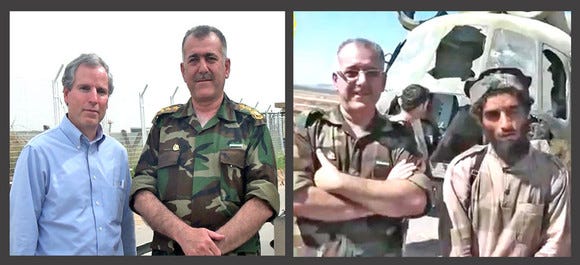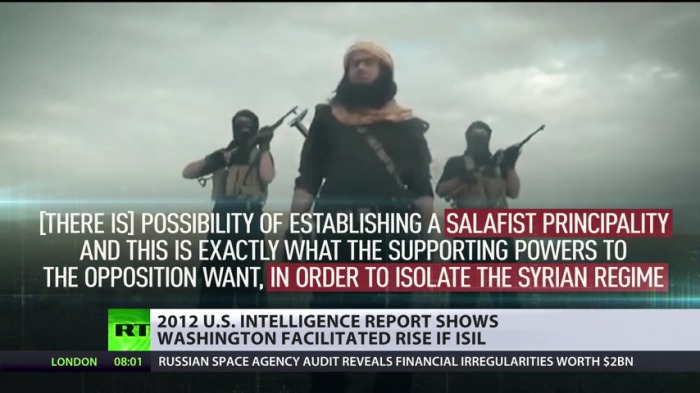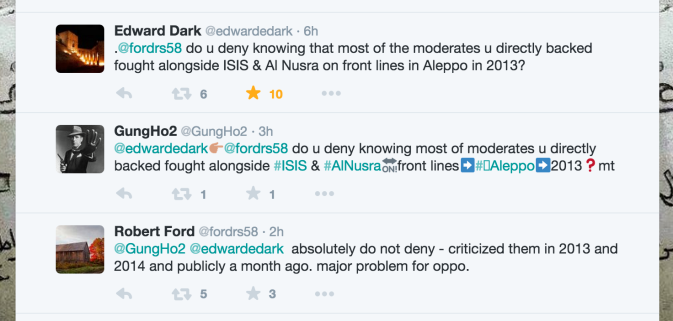 Left: U.S. Ambassador to Syria Robert Ford with FSA Col. Okaidi in 2013. Right: FSA Col. Okaidi with ISIS emir Abu Jandal — part of Omar the Chechen’s group of fighters at Menagh Airbase in 2013.
Left: U.S. Ambassador to Syria Robert Ford with FSA Col. Okaidi in 2013. Right: FSA Col. Okaidi with ISIS emir Abu Jandal — part of Omar the Chechen’s group of fighters at Menagh Airbase in 2013.

by Robert Barsocchini
Here, I wrote that these documents “may” say the US/West wanted/want a Salafist Principality in Eastern Syria, because the declassified docs 1) say “Salafist, Muslim Brotherhood, and AQI are the major forces driving the insurgency in Syria”; 2) in the next sentence, the doc defines the “The West, Gulf Countries, and Turkey” as the countries that “support the opposition”; 3) they later say the “opposition forces are trying to control the Eastern areas”, where Syria borders Iraq, and, specifically of this control of Eastern areas, say the “Western Countries, the Gulf States, and Turkey are supporting these efforts”. 4) In a section about “effects on Iraq” the docs say that “there is a possibility of establishing a declared or undeclared Salafist Principality in Eastern Syria…”, then say “this is exactly what the supporting powers to the opposition want, in order to isolate the Syrian regime, which is considered the depth of the Shia expansion (Iraq and Iran).”
However, while the document begins by stating that “The West, Gulf Countries, and Turkey support the opposition”, the document, as noted, also defines other groups, which could be considered “powers”, as either components of or supporters of the opposition: Salafists, Muslim Brotherhood, and AQI. The report states: “AQI supported the opposition from the beginning…”
While the FSA is defined as “opposition”, Salafists, Muslim Brotherhood, and AQI are initially described as “the major forces driving the insurgency”, not as “the opposition”. It could be that the document means that the FSA is “the opposition” and the West, its allies, and the Islamic groups are simply all supporting them, but with different individual goals. However, AQI is also directly described as “opposition” to Assad: “AQI declared its opposition of Assad’s government because it considered it a sectarian regime targeting Sunnis.”
In the section that says “there is a possibility of establishing a declared or undeclared Salafist Principality in Eastern Syria…”, then that “this is exactly what the supporting powers to the opposition want”—this section of the doc defines the opposition forces controlling the Iraq/Syria border as “Syrian Free Army”, the FSA, and says the FSA will try to take “advantage of the sympathy of the Iraqi border population”.
It then says that “If the situation [likely meaning FSA control of the border] unravels there is the possibility of establishing a declared or undeclared Salafist Principality in Eastern Syria (Hasaka and Der Zor), and this is exactly what the supporting powers to the opposition want, in order to isolate the Syrian regime, which is considered the strategic depth of the Shia expansion (Iraq and Iran).” (The US obviously opposes Iranian expansion and sides with the Sunnis, but the last part of this sentence, as it is framed in terms of Shia expansion, may suggest that here the “supporting powers to the opposition” may be referring not the sentence stating “The West, Gulf Countries, and Turkey support the opposition”, but to earlier sentences stating “AQI supported the opposition from the beginning…” and “AQI declared its opposition of Assad’s government because it considered it a sectarian regime targeting Sunnis.”
Thus, perhaps this is simply unclear writing, or too much is censored, and what this really means is that while both AQI and “The West, Gulf Countries, and Turkey” support the “opposition” (and AQI also comprises the opposition), only the AQI part of that support for the opposition would want a “Salafist Principality” to be established. This is clearly stated regarding the effect on Iraq. However, the US/West do strongly support existing Salafist Principalities, as noted above, including the most ideologically expansionist one, Saudi Arabia. Thus, supporting a Salafist Principality, and annexation of territory (Israel, Cuba, Diego Garcia, etc.), is something the US already does currently. (International relations scholar Dr. Nafeez Ahmed notes that a RAND corp report previously advised the US “to capitalise on the Shia-Sunni conflict by taking the side of the conservative Sunni regimes in a decisive fashion and working with them against all Shiite empowerment movements in the Muslim world.”)
The doc says the above-noted “deterioration”, likely referring to the ‘unravels’ term above, “has dire consequences on the Iraq situation.” It continues that this “deterioration” would give more momentum to terrorist groups and could allow them to declare an “Islamic state”, “which will create grave danger in regards to unifying Iraq and the protection of its territory.” (A study out of British universities noted that US government/media did not report on ISIS publicly until it began to seize oil fields. Then, the study shows, the US sent drones to try to stop ISIS.)
The last uncensored sentence of the doc says that the third consequence of the “deterioration of the situation” (‘the situation’ likely meaning the FSA control of the border region) would be terrorist elements from all over the Arab world “entering into Iraqi arena.”
The rest of the document is censored, as are some sections before this.
Overall, what we can see in the document clearly states that a Salafist Principality is not desired by the West in terms of the Iraqi situation, but may or may not suggest that this principality is desired in terms of isolating Assad, which is a stated goal of the West and its allies (not just isolating, but removing). However, it is also a goal of AQI and its allies, which are defined both as supporting “the opposition” and having “declared its opposition of Assad’s government”. While this group and its affiliates could be viewed as a strategic asset for isolating Assad, they could also be viewed as a third party outside the wider global contest between West and East, which is opposed to either. However, a group in Syria opposed to both sides could be seen as preferable to having a group allied with the East and opposed to the West.
International security scholar Dr. Nafeez Ahmed analyzes these documents and concludes the US practices a policy of “sponsoring Islamist terrorism for dubious geopolitical purposes.”
“According to the newly declassified US document, the Pentagon foresaw the likely rise of the ‘Islamic State’ as a direct consequence of this strategy, and warned that it could destabilize Iraq. Despite anticipating that Western, Gulf state and Turkish support for the “Syrian opposition” — which included al-Qaeda in Iraq — could lead to the emergence of an ‘Islamic State’ in Iraq and Syria (ISIS), the document provides no indication of any decision to reverse the policy of support to the Syrian rebels. On the contrary, the emergence of an al-Qaeda affiliated “Salafist Principality” as a result is described as a strategic opportunity to isolate Assad.”
“The secret Pentagon document thus provides extraordinary confirmation that the US-led coalition currently fighting ISIS, had three years ago welcomed the emergence of an extremist “Salafist Principality” in the region as a way to undermine Assad, and block off the strategic expansion of Iran.”
“The establishment of such a “Salafist Principality” in eastern Syria, the DIA document asserts, is “exactly” what the “supporting powers to the [Syrian] opposition want.” Earlier on, the document repeatedly describes those “supporting powers” as “the West, Gulf countries, and Turkey.”
Charles Shoebridge, a former British Army and Metropolitan Police counter-terrorism intelligence officer, said (noted by Ahmed) that the documents “raise vitally important questions of the West’s governments and media in their support of Syria’s rebellion.”
“Throughout the early years of the Syria crisis, the US and UK governments, and almost universally the West’s mainstream media, promoted Syria’s rebels as moderate, liberal, secular, democratic, and therefore deserving of the West’s support. Given that these documents wholly undermine this assessment, it’s significant that the West’s media has now, despite their immense significance, almost entirely ignored them.”
Ahmed quotes a former US Marine: “US intelligence predicted the rise of the Islamic State in Iraq and the Levant (ISIL or ISIS), but instead of clearly delineating the group as an enemy, the report envisions the terror group as a US strategic asset.”
Ahmed concludes: “The rise of a Salafist quasi-state entity that might expand into Iraq, and fracture that country, was therefore clearly foreseen by US intelligence as likely — but nevertheless strategically useful — blowback from the West’s commitment to “isolating Syria.”
What the docs establish beyond doubt is that, in 2012, when they were written, the US saw the likelihood of a “Salafist Principality” or “Islamic State” being established, and was fully aware the insurgency in Syria was mainly driven by Islamic groups, who were fighting Assad and also supporting the FSA, which itself has been shown to have Islamic tendencies. For example, an FSA commander is on video saying he would want to implement Sharia law. But the West and its allies continued their support, as FSA members openly shared their US supplies with the ISIS-related groups, and even converted to ISIS.
As Ahmed puts it, “the Pentagon continued to support the Islamist insurgency, even while anticipating the probability that doing so would establish an extremist Salafi stronghold in Syria and Iraq.”
This “entire covert strategy was sanctioned and supervised by the US, Britain, France, Israel and other Western powers.”
“As Shoebridge told me, ‘The documents show that not only did the US government at the latest by August 2012 know the true extremist nature and likely outcome of Syria’s rebellion’ — namely, the emergence of ISIS — ’but that this was considered an advantage for US foreign policy. This also suggests a decision to spend years in an effort to deliberately mislead the West’s public, via a compliant media, into believing that Syria’s rebellion was overwhelmingly ‘moderate.’”
Ahmed quotes a former MI5 officer explaining that after Libya and other such projects by the West, we see in this behavior towards Syria “part of an established pattern. And they remain indifferent to the sheer scale of human suffering that is unleashed as a result of such game-playing.”
What we already knew before these docs is that the US and West strongly support extremist Salafist states as part of their strategy of eating away at the parts of the world not under the US thumb, the “East”: Syria, Iran, Russia, and China. The US and West themselves are built on and continue to support and commit theft and annexation of territory, and support, commit, or ignore (if they are not politically helpful) all kinds of mass killings, including by groups worse than ISIS; these have included the Khmer Rouge, the Suharto Regime, and the US itself: the establishment of the USA and the building of it into a superpower was a process that involved crimes worse than anything ISIS will ever accomplish.
Further, ISIS, as pointed out by Kofi Annan and many others, arose as a consequence of the illegal US invasion of Iraq, motivated largely by Bush Jr.’s religious fanaticism, an invasion the international community tried and failed to prevent, which, the most recent and comprehensive report finds, has killed about 1 to 2 million or more people, another feat ISIS will never accomplish.
While studies and many official statements make clear, and it is obvious to any minimally non-US-brainwashed individual, that the invasion was largely about oil, even if we disregard that, ignore the rest of US history, and declare the US had/has “good intentions” regarding Iraq, that puts us at the level of of Japanese fascists, who believed in their “good intentions” regarding their invasions of China and elsewhere.
People with too much power always declare good intentions, and are often sincere, as they get god-complexes and view themselves as humanity’s benevolent saviors. But the reason war (including supporting warring proxies) is outlawed as an instrument of policy is that it has disastrous consequences, as we are seeing, even for the sincerely well-intentioned.
Additional Notes:
It should be stressed that clearly admitting the West would “want” a Salafist principality in Eastern Syria is not generally the kind of statement people in governments would make of themselves, even in private, hence makes it less likely here that the West is being referred to specifically by that statement, as does the inclusion of the phrase “if the situation unravels” (meaning FSA control of the East) an Islamic state could result. However, it is noteworthy that the West and the Islamists are so easily conflated in this document (this conflation may well be intentional as a way of discussing benefits without clearly stating that they might be desired), as they are clearly delineated as both being opposed to the Assad government, and for similar reasons – opposing Iran and the Shia, backed by Russia and China, the latter part being of greater import to the West. The doc also makes very clear that the FSA was/is being supported by AQI and its Islamist affiliates, and that those Islamists were known to be “the major forces driving the insurgency”. It has long been known that FSA shares its US/Western/Gulf/Turkish supplies with and converts to Islamist groups, and AQI, the ISIS precursor, has always been known as particularly aggressive. And as Dr. Ahmed points out, the document nowhere suggests ending aid to the opposition due to its being driven by AQI and affiliates, and only frames the potential creation of the “Islamic state” as a bad thing in relation to Iraq. In relation to Syria/Assad, it is not framed as a bad thing, but as something that would be seen to “isolate” Assad, a goal shared by the West and the Islamist groups. So, these documents may well be an example of discussing a strategy while attempting to maintain some degree of “plausible deniability”.
It must also be remembered that the US and West not only support extremist Salafi/Wahhabi/Sharia established states, but have on numerous occasions worked with, backed, aided and/or paralleled some of the goals of non-state groups such as the Mujahedin and al Qaeda (in Afghanistan – see Brzezinski, Bob Gates; Bosnia, Kosovo – on these see Fulton in scholarly journal Global Security Studies), including under Obama in relation to Libya. In US support for the Mujahedin in Afghanistan and then the Taliban, the support was not even seen as a means to an end, but a completely acceptable end in itself: the US was fine with the Taliban taking power and staying in power, as long as it cooperated with the US. That is the bottom line. As soon as it proved uncooperative, the US “discovered” the Taliban human rights violations that non-governmental US monitors had been decrying for years, while the US was supporting the Taliban (here). And, as noted, abhorrent behavior is not a deterrent to US support. The US has committed far worse crimes than ISIS and supported groups far worse than ISIS. Only those unfamiliar with history and glued to US TV can think ISIS is some new level of evil in the world, or at least one not seen for a long time. The only qualifier for US support is whether the group in question is willing to cater to US business and strategic interests.
 ISIS Commander Abu Omar al-Shishani celebrates after his joint FSA/ISIS operation at Menagh Airbase in the summer of 2013. (Photo circulated in jihadi social media)
ISIS Commander Abu Omar al-Shishani celebrates after his joint FSA/ISIS operation at Menagh Airbase in the summer of 2013. (Photo circulated in jihadi social media)
